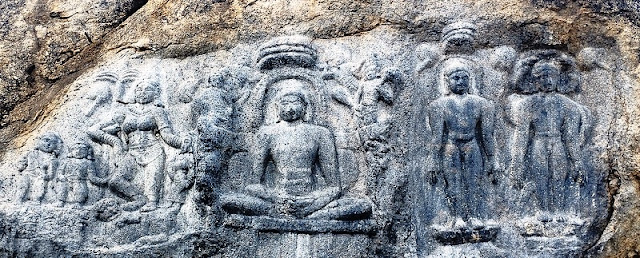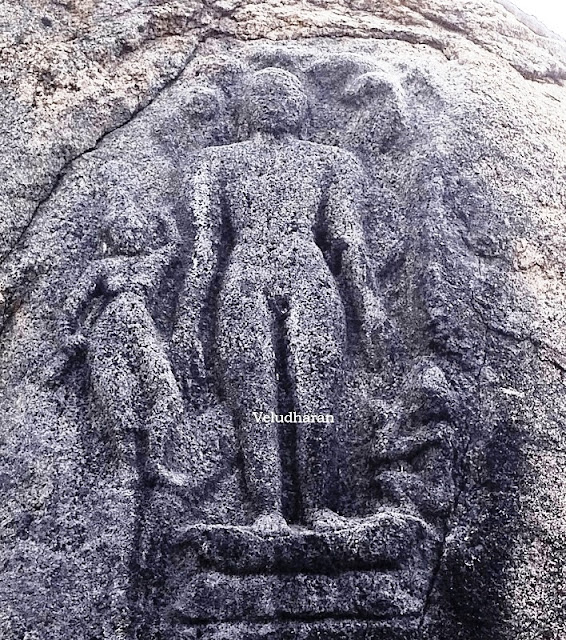The
Visit to this Sri Agastheeswarar Temple at Ananthamangalam Village was a part
of “Shiva, Jain Temples and Heritage Sites Visit” at Saram and Ananthamangalam
near Tindivanam, on 04th February 2024. This Agastheeswarar Temple
is on the north side of the Village before the Hill Shiva Temple and Jain
monument.
Moolavar : Sri Agastheeswarar
Consort : Sri Ranganayaki
Some
of the salient features of this temple are…
The
temple is facing east. The temple tank is on the north side of the temple.
Stucco images of Shiva and Parvati is on the top of the maha mandapam.
Balipeedam and Rishabam are in front of the temple. Vinayagar and Murugan are
on both sides of the sanctum sanctorum. Utsavars are in the antarala. Moolavar
is on a round Avudayar. In kostam Vinayagar, Dakshinamurthy, Lingothbavar and Durgai.
In
praharam Navagrahas, Chandikeswarar and Bairavar. Ambal Sri Ranganayaki is in a
separate sannidhi facing South. Ambal is standing posture with abhaya varada
hastam.
ARCHITECTURE
The
temple consists of sanctum sanctorum, antarala and ardha / maha mandapam. The
sanctum sanctorum is on Pada bandha adhistanam with three patta kumudam and
Pattikai. The Bhitti starts with vedika. The pilasters are of brahmakantha
pilasters with kalasam, kudam palakai and Vettu pothyal. The Prastaram is with
plain valapi and kapotam. The vimanam above prastaram was built with bricks.
The vimanam is of one tala, greevam and vesara sigaram. Shiva, Dakshinamurthy,
Maha Vishnu and Brahma are on the tala and greeva koshtams.
HISTORY AND INSCRIPTION
The
original temple belongs to Chozha period and letter reconstructed during
Vijayanagara period. Again the temple was in dilapidated condition and the same
was reconstructed during recent years.
அனந்தமங்கலம்
மதுராந்தகம் வட்டம் ஒரத்தி உள்வட்டத்தில் அனந்தமங்கலம் என்ற புராதனமான ஊர்
அமைந்துள்ளது. ஒய்மாநாட்டுத் திருநலூர் நாட்டில் இவ்வூர் அமைந்திருந்தது. அரங்கமங்கலம்,
அரங்கைப்பதி
என்றெல்லாம் இவ்வூர் அழைக்கப்பட்டுள்ளது. ஏரி தூம்பு எடுத்ததைச் சுட்டும் கல்வெட்டு வாசகம் வருமாறு:
1. ஸ்வஸ்திஸ்ரீ கம்பவன்மற்கு யாண்டு
2. இருபத்தொன்றாவது
3. அவநிமங்கலத்து
4. செங்குட்டி செய்வித்த தூம்பு.
அவநிமங்கலமே அனந்தமங்கலமாயிற்று போலும். இதுவே ஊரில் உள்ள தொன்மையான
கல்வெட்டாகும்
There are 5 Inscriptions recorded from this
temple. One of the 11th Century inscription in the form of Poem, records
that, Anangai Pathipichchan’s son Kodasaththan Keni Kizharkon, had
reconstructed this temple with stone.
அனந்தமங்கலம் ஊரில் அகத்தீஸ்வரர் என்ற பெயரில் சிவன்கோயில் உள்ளது. கோயிலில்
ஐந்து கல்வெட்டுகள் உள்ளன. கி.பி. 11ஆம் நூற்றாண்டளவில் அநங்கைப் பதிபிச்சன்
என்பவனின் மகன் கோடச்சாத்தன் கேணி கிழார்கோன் என்பவன் அகத்தீஸ்வரர் கோயிலைக்
கற்றளியாக்கியதைப் பாடல் கல்வெட்டு குறிப்பிடுகிறது.
The Kulothunga Chozha-I’s 1097 CE
inscription mentions the Shiva’s name as Aludaiyar Agastheeswaramudaiya
Nayanar. This inscription records the endowment of burning lamp.
கி. பி. 1097 இல் வெட்டப்பட்ட முதல் குலோத்துங்கனுடைய
கல்வெட்டு இறைவனை ஆளுடையார் அகத்தீஸ்வரமுடைய நாயனார் என அழைக்கிறது. விளக்குக்கொடை
இதில் இடம் பெறுகிறது.
Vikrama Chozha’s period 1123 CE also
mention’s Shiva’s name as Aludaiyar
Agastheeswaramudaiya Nayanar. This inscription records the gift of Land after
exempting the taxes.
விக்கிரம சோழனுடைய ஆட்சியின்போது கி. பி. 1123 ஆம் ஆண்டில் வெட்டப்பட்ட கல்வெட்டும் மேலே
குறிப்பிட்ட பெயரையே குறிப்பிடுகிறது. வரி நீக்கி நிலமளித்ததை இது
குறிப்பிடுகிறது.
Rajaraja-III’s period inscription gift of
Padikaval Tax to this temple, Thirupani / renovations.
மூன்றாம் இராசராசன் காலக் கல்வெட்டு ஒன்று பாடிகாவல் வரியைக் கோயில் திருப்
பணிக்கு வழங்கிய கொடையைச் சுட்டுகிறது.
Another inscription records that
Athirajendra Nallur alias Arangamangalam Thiruvagatheeswaramudaiyar Temple’s
Thirupani, was organised by Rajanarayana Sambuvarayan alias Seeyaballavan.
அதிராஜேந்திர நல்லூராகிய அரங்கமங்கலத்துத் திருவகத்தீஸ்வரமுடையார் கோயில்
திருப்பணிக்கு இராஜநாராயண சம்புவராயனாகிய சீயபல்லவன் ஏற்பாடு செய்துள்ளான்.
Ref:
Tholliyal
Nokkil Kanchipura Mavattam, by S Krishnamurthy.
Maha
Kumbhabhishekam was conducted after the re-construction of the temple in 2023.
LEGENDS
During
Celestial wedding of Shiva with Parvati, all the Devas, Maharaishis, Munis assembled
at Mount Kailash. Due to this the north side of this earth went down and south
side went up. To balance the earth Shiva asked the sage Agasthiyar to go to
south. After getting the boon of Celestial wedding darshan whenever he wants,
Agasthiyar started his journey to Pothigai Hills. On the way he installed and
worshipped Shiva Lingas on many places. It is believed that sage Agasthiyar
worshipped Shiva of this temple. Hence Shiva is called as Agastheeswarar.
POOJAS AND CELEBRATIONS
Apart
from regular poojas, special poojas are conducted on pardosham, Maha
Shivaratri.
TEMPLE TIMINGS
Since
oru kala Poojas is conducted, the opening and closing times are unpredictable.
CONTACT DETAILS
HOW TO REACH
This
temple is on the north side of the Village Ananthamangalam. Town bus no 24 is
available from Gandhi statue stop at Tindivanam.
This
place is about 17 KM from Tindivanam, 26 KM from Melmaruvathur, 92 KM from
Tambaram, 134 KM from Chennai Central station.
Nearest
Railway station is Tindivanam.
LOCATION OF THE TEMPLE : CLICK HERE

















































